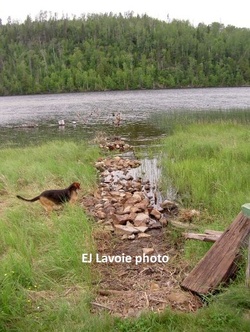
If a tree falls in the forest and there is no one there to hear it, does it make a sound?
The answer is yes.
If a tsunami sweeps across an inland lake in the boreal forest, and there is no one there to see it, did it happen?
Maybe.
It depends on the track it leaves.
I have paddled across a big lake in a storm, in the teeth of a gale, for a solid two hours, non-stop, because if I stopped, I was dead. When I finally looked back, there was no track. It might have never happened.
Lake Nipigon is one of Canada's biggest lakes. I have canoed it, but . . . never in a storm. I was caught in a storm there once, and, apparently, I lived.
If I'd been out paddling a couple weeks ago, I would have, apparently, died.
In this neck of the woods, they call a tsunami a seiche (pronounced SAY –sh). A strong westerly wind piled the water into a ridge and sent it rippling across the broad expanse of Lake Nipigon into the southeast arm, where the steep hills and narrowing corridor exacerbated the phenomenon.
I know it happened because I saw its track, two weeks later.
In September of 2009, my friend Peter took me sailing up the arm and into the open lake. I was researching the shoreline for my novel, The Beardmore Relics. It was breezy, but pleasant. And we returned safely, apparently, to the dock.
That dock is no longer there . . .
ORIGINAL POST June 2011
Read the full post with colour photos on E.J. Lavoie's Blog > http://bit.ly/2cCrgB0
The answer is yes.
If a tsunami sweeps across an inland lake in the boreal forest, and there is no one there to see it, did it happen?
Maybe.
It depends on the track it leaves.
I have paddled across a big lake in a storm, in the teeth of a gale, for a solid two hours, non-stop, because if I stopped, I was dead. When I finally looked back, there was no track. It might have never happened.
Lake Nipigon is one of Canada's biggest lakes. I have canoed it, but . . . never in a storm. I was caught in a storm there once, and, apparently, I lived.
If I'd been out paddling a couple weeks ago, I would have, apparently, died.
In this neck of the woods, they call a tsunami a seiche (pronounced SAY –sh). A strong westerly wind piled the water into a ridge and sent it rippling across the broad expanse of Lake Nipigon into the southeast arm, where the steep hills and narrowing corridor exacerbated the phenomenon.
I know it happened because I saw its track, two weeks later.
In September of 2009, my friend Peter took me sailing up the arm and into the open lake. I was researching the shoreline for my novel, The Beardmore Relics. It was breezy, but pleasant. And we returned safely, apparently, to the dock.
That dock is no longer there . . .
ORIGINAL POST June 2011
Read the full post with colour photos on E.J. Lavoie's Blog > http://bit.ly/2cCrgB0
 RSS Feed
RSS Feed
